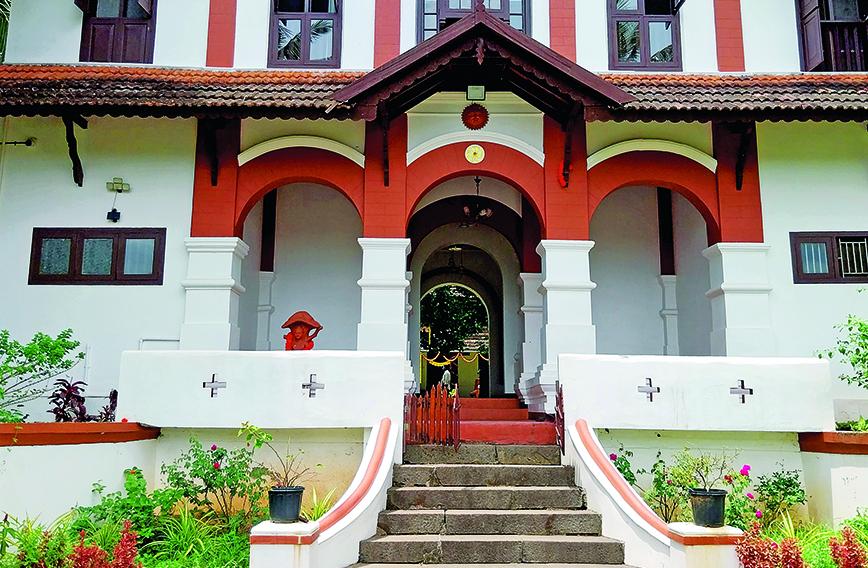
The Heritage 1866 is a 158-year-old manor that has been restored
Cricket, cake, circus
Susheela Nair
Thalassery has the distinction of being the land of cakes, circuses, cricket, Communism, looms, lore, spices and Theyyam, a ritual art form. As I strolled into the bungalow at The Heritage 1866, a premium heritage homestay, I felt at ease at once. A flight of steps leads to an imposing gateway which catches one’s attention. The genesis of the 158-year-old manor can be traced back to the late freedom fighter, Ryru Nair. This majestic bungalow has been restored meticulously under the supervision of its present owners.
With lofty wooden ceilings, decorated flooring and an antiquated ambience, every corner breathes history. The very essence of Kerala seems to have filtered through the doors of the manor. Rooms in the bungalow are named after flowers. Some of the rooms are river-facing while others overlook the courtyard. The interiors have decorative touches like a Theyyam mural. Notable among the collection of treasured artefacts is a water pitcher gifted by Netaji Subhas Chandra Bose to Ryru Nair.
Beyond the tranquil confines of The Heritage Bungalow are a myriad of tourist attractions but we chose to explore just a few. We started with the Thalassery Fort, built in 1708 on a headland facing the sea. Clambering up to the fort, we were rewarded with a captivating view of the sea. As we ambled around, we could see laterite walls, cannons, turrets, imposing bastions on the flanks and pepper cellars from which trade was conducted. Mysterious and secret underground tunnels that lead to the sea are blocked now and a short lighthouse on its flank lies disused.
Half a kilometre away is the Odathil Palli, a mosque, built by Moosa Kakka of the Keyis family around 1806. It is a blend of Hindu and Muslim architecture. Sans any minarets, it is noted for its copper plate roofing, abundant use of wood, wooden walls and pillars with intricate carvings. The three-storeyed mosque epitomizes the beauty and versatility of Kerala craftsmanship. Non-Muslims are not allowed entry to the mosque.
We headed to Gundert Museum, a treasure trove of knowledge. It is housed in a sprawling bungalow amidst verdant lawns, which is built in traditional Kerala architectural style, with tiled roofs and spacious verandahs which run along the four sides.
It boasts of digital installations on Dr Herman Gundert, the German missionary and renowned scholar who compiled the first Malayalam-English dictionary. Equipped with headphones, I listened to Gundert’s biographical audio, replete with images, names and significant events from his life. The museum had different zones, each offering a unique experience. It sheds light on the life and contributions of Gundert, who is remembered for his invaluable contributions to the Malayalam language, and Malabar’s cultural and linguistic landscape. His other contribution is the establishment of the first printing press in Malabar.
At Muzhappilangad beach — said to be India’s only drive-in beach at low tide — we saw tourists zipping and zooming past on motorbikes and others testing their motoring skills in four-wheel drives. We took a leisurely stroll along the four-km stretch and then relaxed blissfully on the beach overlooking the enchanting island of Dharmadam, a five-acre island encircled by a river and the sea. This lush, palm-covered spot, locally known as pacha thuruth (green island), sits beyond the confluence of the Anjarakandi and Thalassery rivers, just 100 metres from the sandy beach of Dharmadam, which itself is set off from the mainland by rivers that surround it on three sides with the sea to its west.
A Buddhist stronghold, it was earlier known as Dharmapattanam. One can see the water gushing up madly and receding as quickly by turns. At low tide, one can dally in knee-deep water for hours on end and wade to the island. There are laterite cliffs with deep fissures in some, protruding into the sea. The eeriness on a new moon night with the waves dashing furiously against the ring of laterite cliffs lingered long in our memories after the trip.
Cakes came to Kerala when an early British settler, craving Christmastime cake, got a local cook to reproduce the rich fare after obtaining the ingredients for it. It started the practice of baking that continues to this day in Kerala.
History was made when Mambally Bapu, owner of The Royal Biscuit Factory, baked arguably India’s first plum cake that led to Thalassery’s unofficial title, Land of three Cs — Cakes, Cricket and Circus. Although the original bakery is not there, we stopped by the current one in a mall to have wood-fired gourmet handcrafted plum cake, crispy, scrumptious barley biscuits and other goodies.
Thalassery is said to be the birthplace of the Indian circus tradition. As for cricket, it was Arthur Wellesley, Duke of Wellington, who first introduced the game among commoners.
Besides these three Cs, Thalassery has other claims to fame. It is the birthplace of Communism in Kerala and one can see a proliferation of cooperatives involved in coir weaving, beedi-making, and so on. It was a treat to watch weavers at work on traditional pit looms, handlooms and shuttles, weaving cotton and silk fabrics, at Pinarayi. Our Kannur sojourn culminated with watching a ritualistic Theyyam performance featuring colourfully costumed performers depicting fascinating folk tales.
Back at the bungalow, after a hectic sightseeing spree, we indulged in the diverse snacks churned out by the kitchen staff. Sweet treats like muttamala (egg yolk noodles) and unnakaya (fried bananas) offer a delightful contrast to savoury bites like ari pathri (spiced flatbreads) and kallumakaya (mussel specialities). Petti pathiri, bread stuffed with meat, is a must-indulge delicacy. But the highlight is the Thalassery biryani, made using kaima/jeerakalasa, an Indian aromatic rice, instead of the usual basmati rice, tender meat, and a symphony of spices like cloves, cinnamon and cardamom.
Comments
Currently there are no Comments. Be first to write a comment!



